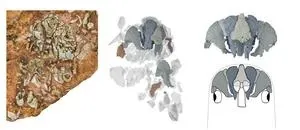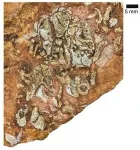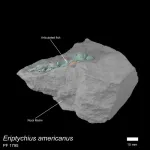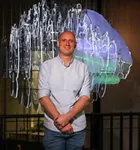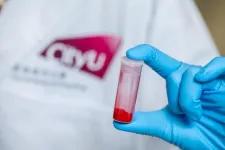(Press-News.org) One proven method for tracking down the genetic causes of diseases is to knock out a single gene in animals and study the consequences this has for the organism. The problem is that for many diseases, the pathology is determined by multiple genes. This makes it extremely difficult for scientists to determine the extent to which any one of the genes is involved in the disease. To do this, they would have to perform many animal experiments – one for each desired gene modification.
Researchers led by Randall Platt, Professor of Biological Engineering at the Department of Biosystems Science and Engineering at ETH Zurich in Basel, have now developed a method that will greatly simplify and speed up research with laboratory animals: using the CRISPR-Cas gene scissors, they simultaneously make several dozen gene changes in the cells of a single animal, much like a mosaic. While no more than one gene is altered in each cell, the various cells within an organ are altered in different ways. Individual cells can then be precisely analysed. This enables researchers to study the ramifications of many different gene changes in a single experiment.
First time in adult animals
For the first time, the ETH Zurich researchers have now successfully applied this approach in living animals – specifically, in adult mice – as they report in the current issue of Nature. Other scientists had previously developed a similar approach for cells in culture or animal embryos.
To “inform” the mice’s cells as to which genes the CRISPR-Cas gene scissors should destroy, the researchers used the adeno-associated virus (AAV), a delivery strategy that can target any organ. They prepared the viruses so that each virus particle carried the information to destroy a particular gene, then infected the mice with a mixture of viruses carrying different instructions for gene destruction. In this way, they were able to switch off different genes in the cells of one organ. For this study, they chose the brain.
New pathogenic genes discovered
Using this method, the researchers from ETH Zurich, together with colleagues from the University of Geneva, obtained new clues to a rare genetic disorder in humans, known as 22q11.2 deletion syndrome. Patients affected by the disease show many different symptoms, typically diagnosed with other conditions such as schizophrenia and autism spectrum disorder. Before now, it was known that a chromosomal region containing 106 genes is responsible for this disease. It was also known that the disease was associated with multiple genes, however, it was not known which of the genes played which part in the disease.
For their study in mice, the researchers focused on 29 genes of this chromosomal region that are also active in the mouse brain. In each individual mouse brain cell, they modified one of these 29 genes and then analysed the RNA profiles of those brain cells. The scientists were able to show that three of these genes are largely responsible for the dysfunction of brain cells. In addition, they found patterns in the mouse cells that are reminiscent of schizophrenia and autism spectrum disorders. Among the three genes, one was already known, but the other two had not previously been the focus of much scientific attention.
“If we know which genes in a disease have abnormal activity, we can try to develop drugs that compensate for that abnormality,” says António Santinha, a doctoral student in Platt’s group and lead author of the study.
Patent pending
The method would also be suitable for use in studying other genetic disorders. “In many congenital diseases, multiple genes play a role, not just one, Santinha says. “This is also the case with mental illnesses such as schizophrenia. Our technique now lets us study such diseases and their genetic causes directly in fully grown animals.” The number of modified genes could be increased from the current 29 to several hundred genes per experiment.
“It’s a big advantage that we can now do these analyses in living organisms, because cells behave differently in culture to how they do as part of a living body,” Santinha says. Another advantage is that the scientists can simply inject the AAVs into the animals’ bloodstreams. There are various different AAVs with different functional properties. In this study, researchers used a virus that enters the animals’ brains. “Depending on what you’re trying to investigate, though, you could also use AAVs that target other organs,” Santinha says.
ETH Zurich has applied for a patent on the technology. The researchers now want to use it as part of a spin-off they are establishing.
***
Perturbing the genome
The technique presented here is one of a series of new genetic editing methods used to alter the genome of cells in a mosaic-like manner. CRISPR perturbation is the technical term for this research approach that involves the perturbation of the genome using CRISPR-Cas gene scissors. This approach is currently revolutionising research in the life sciences. It makes it possible to obtain a great deal of information from a single scientific experiment. As a result, the approach has the potential to accelerate biomedical research, such as in the search for the molecular causes of genetically complex diseases.
A week ago, another research group from the Department of Biosystems Science and Engineering at ETH Zurich in Basel, working with a team from Vienna, published a study in which they applied CRISPR perturbation in organoids (see ETH News). Organoids are microtissue spheroids that are grown from stem cells and have a similar structure to real organs – in other words, they are a sort of miniature organ. They are an animal-free research method that complements research on animals. Because both methods – CRISPR perturbation in animals and in organoids – can provide more information with fewer experiments, both have the potential to ultimately reduce the number of animal experiments.
END
Genetically modifying individual cells in animals
2023-09-20
ELSE PRESS RELEASES FROM THIS DATE:
County-level sociodemographic characteristics and availability of COVID-19 therapeutic drugs
2023-09-20
About The Study: The results of this study showed sociodemographic-based disparities in geographic clustering of COVID-19 therapeutic drugs, highlighting disparities in access to these drugs. With the end of the COVID-19 Public Health Emergency, these findings highlight an important gap in treatment access.
Authors: Kosuke Tamura, Ph.D., of the National Institutes of Health in Bethesda, Maryland, is the corresponding author.
To access the embargoed study: Visit our For The Media website at this link https://media.jamanetwork.com/
(doi:10.1001/jamanetworkopen.2023.34763)
Editor’s ...
Consumption of ultraprocessed food and risk of depression
2023-09-20
About The Study: The findings of this study suggest that greater ultraprocessed food (UPF; i.e., energy-dense, palatable, and ready-to-eat items) intake, particularly artificial sweeteners and artificially sweetened beverages, is associated with increased risk of depression. Although the mechanism associating UPF to depression is unknown, recent experimental data suggests that artificial sweeteners elicit purinergic transmission in the brain, which may be involved in the etiopathogenesis of depression.
Authors: Raaj S. Mehta, ...
Surrogate adiposity markers and mortality
2023-09-20
About The Study: Waist-to-hip ratio had the strongest and most consistent association with mortality irrespective of body mass index in this study consisting of 387,000 UK adult participants from the UK Biobank. Clinical recommendations should consider focusing on adiposity distribution compared with mass.
Authors: Guillaume Pare, M.D., M.Sc., of the Vascular and Stroke Research Institute in Hamilton, Ontario, Canada, is the corresponding author.
To access the embargoed study: Visit our For The Media website at this link https://media.jamanetwork.com/
(doi:10.1001/jamanetworkopen.2023.34836)
Editor’s Note: Please see the article for additional ...
Strengthening artificial immune cells to fight cancer
2023-09-20
Among available immunotherapies, the use of «CAR-T» cells is proving extremely effective against certain blood cancers, but only in half of patients. A main reason for this is the premature dysfunction of these immune cells, which have been artificially modified in vitro. A team from the Universities of Geneva (UNIGE), Lausanne (UNIL), the Geneva University Hospitals (HUG) and the Vaud University Hospital (CHUV), all part of the Swiss Cancer Center Léman (SCCL), has discovered how to prolong the functionality of CAR-T cells. By inhibiting a very specific metabolic mechanism, the team has succeeded ...
Prehistoric fish fills 100 million year gap in evolution of the skull
2023-09-20
A 455-million-year-old fossil fish provides a new perspective on how vertebrates evolved to protect their brains, a study has found.
In a paper published in Nature today (Wednesday 20th September), researchers from the University of Birmingham, Naturalis Biodiversity Centre in Leiden, Netherlands; and the Natural History Museum have pieced together the skull of Eriptychius americanus.
The research, funded by the Leverhulme Trust, suggests that the ancient jawless fish found in ancient deposits in ...
Study finds firearm injuries increased in gentrified neighborhoods
2023-09-20
Brigham researchers reported that gentrified neighborhoods had a 62 percent higher firearm injury incidence rate than non-gentrified communities with comparable sociodemographic characteristics
Understanding the reason for this increase is vital to reducing future firearm injuries
Gentrification can have a ripple effect on communities. While it can improve certain conditions in typically low-income areas, rising housing costs can displace residents, causing social disruption and other downstream effects. Investigators from Brigham and Women’s Hospital, a founding member of the Mass General Brigham healthcare system, conducted a study using national data to examine the relationship ...
Scientists reveal how the effects of psychosis spread throughout the brain
2023-09-20
Psychoses like schizophrenia cost billions of dollars annually and derail the lives of people struggling with the disease. Now Monash University researchers have modelled how the effects of psychosis spread through the brain, allowing them to isolate areas where these changes may originate from and which could be targeted by therapies designed to reduce the disease’s progression.
The study, published today in the prestigious Journal of the American Medical Association Psychiatry, details how the scientists were able to map and model the spread of brain changes in people with different stages of psychoses such as schizophrenia,from people newly ...
Ya-Chieh Hsu, Ph.D. (Harvard) and Xuebing Wu, Ph.D. (Columbia) receive inaugural Glenn Foundation Discovery Awards
2023-09-20
Santa Barbara, CA and New York, NY -- The Glenn Foundation for Medical Research (GFMR) and the American Federation for Aging Research (AFAR) are pleased to announce the inaugural recipients of the
2023 Glenn Foundation Discovery Awards:
Ya-Chieh Hsu, PhD, Professor of Stem Cell and Regenerative Biology at Harvard University, and a Principal Faculty Member at the Harvard Stem Cell Institute.
Xuebing Wu, PhD, Assistant Professor of Medical Sciences (in Medicine and in Systems Biology), Columbia University.
The Glenn Foundation Discovery Award was created to support research projects with strong potential to develop pioneering discoveries ...
Decoding depression: Researchers identify crucial biomarker that tracks recovery from treatment-resistant depression
2023-09-20
A team of leading clinicians, engineers, and neuroscientists has made a groundbreaking discovery in the field of treatment-resistant depression. By analyzing the brain activity of patients undergoing deep brain stimulation (DBS), a promising therapy involving implanted electrodes that stimulate the brain, the researchers identified a unique pattern in brain activity that reflects the recovery process in patients with treatment-resistant depression. This pattern, known as a biomarker, serves as a measurable indicator of disease recovery and represents a significant ...
CityU researchers develop novel photo-oxidation therapy for anticancer treatment
2023-09-20
A research team led by scientists from City University of Hong Kong (CityU) has achieved a significant breakthrough by inventing a new class of near-infrared-activated photo-oxidants that can effectively kill cancer cells without requiring oxygen. The photo-oxidants induce a unique form of cancer cell death that can overcome cancer cell resistance. The findings offer a new strategy, called ‘photo-oxidation therapy’, and provide a promising direction for the development of anti-cancer drugs.
Photodynamic therapy, an innovative ...

